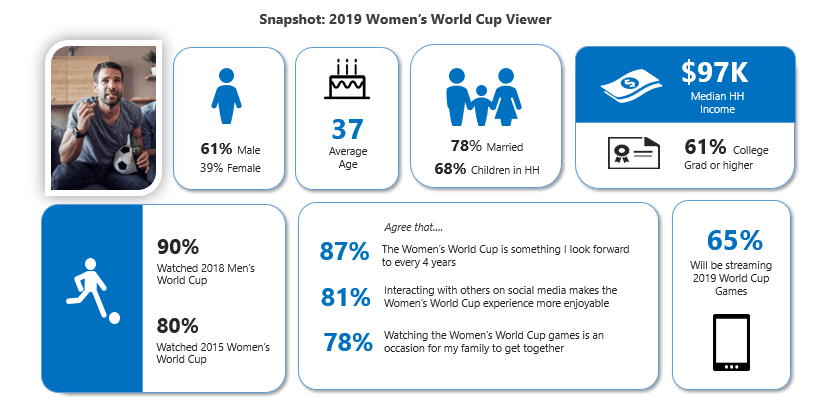2019 FIFA Women’s World Cup: Who’s Watching, Where, and Why
With the not so lofty goal of 1 billion viewers for the 2019 FIFA Women’s World Cup in France, this year’s tournament is poised to be the most exciting to date for a few reasons. France is still buzzing from a Men’s World Cup win in 2017, and the U.S. women’s team is still heavily favored to win this year. But it’s the off the field conversations about gender equality, or the lack thereof, that signal the importance of this year’s games and has helped drive interest to an all-time high. Surprisingly, we know little about who’s watching the games, however. It’s tempting to make assumptions here and just assume that it’s women, but our research tells a different story. We spoke to a nationally representative sample of over 1,200 respondents in the U.S. to help us define the persona of the typical FIFA Women’s World Cup viewer:
2019 FIFA Women’s World Cup Insights
The goal of our nationwide online survey was to measure awareness and interest in the 2019 Women’s World Cup among U.S. Adults. We were also interested in understanding how they will watch the games and engage on social media throughout the tournament. Our study revealed the following key findings:
- 3-out-of-10 U.S. adults have some interest in watching the 2019 Women’s World Cup.
- Overall awareness of this year’s soccer tournament, however, is still relatively low at just under one-third.
- One-quarter of adults reported watching the 2015 Women’s World Cup, but one-third watched last year’s Men’s World Cup.
- Men are significantly more likely than women to be aware of and to show interest in this year’s Women’s World Cup.
- Millennials and Hispanics have stronger interest than the adult population in general.
- Soccer enthusiasts are more likely to be male, married and have larger households. They also have higher education and income levels than the general market.
- While most fans will watch Women’s World Cup matches on regular TV, a large share (18 to 34-year old’s in particular) will also be streaming matches to their TV or other devices.
- World Cup enthusiasts will be interacting with others about the tournament on social media. This is especially true for Millennials.
- Fans are more likely to watch World Cup games with others, particularly among Hispanics.
To download the full report, click HERE.
Women’s World Cup Viewer Persona
So, who is the typical Women’s World Cup Viewer? Our findings suggest that the viewer is:
- Male - 34% of males said they were very interested or somewhat interested in watching any of the Women’s World Cup soccer matches this year vs. 23% of females.
- Millennial - 36% of Millennials 18-34 said they were very interested or somewhat interested in watching any of the Women’s World Cup soccer matches this year vs. 27% of GenXers.
- Hispanic - 41% of Hispanics stated that they were very interested or somewhat interested in watching any of the Women’s World Cup soccer matches this year vs. 25% of non-Hispanic Whites, 22% of African Americans, and 33% of Asians.
- Educated and High-Income Earners - 61% of those very interested in watching the Women’s World Cup have graduated college vs. 39% of the Total Market. The median household income of those very interested in watching the Women’s World Cup this year is $97K vs. $59K for the Total Market.
At a glance, we see that not only are Women’s World Cup viewers male but are family men who look forward to gathering to watch the games.
What It All Means
While awareness of the FIFA Women’s World Cup is generally low compared to popular sporting events like the Super Bowl, the potential to advertise to 1 billion global viewers is almost too tempting to pass up. Smart advertisers will forgo the typical sponsorships high on octane and low on substance in favor of more thoughtful ads that appeal to not only high-income Hispanic viewers, especially males, but the women in their lives. Ads that challenge current conventions, empower, and create meaningful conversations where viewers watch the games will have an impact. Be that social media (globally, soccer is the most popular sport on Facebook and Instagram with three times more followers than any other sport) or streaming, brands that advertise during the Women’s World Cup have an opportunity to create immersive experiences that will be remembered after the last goal is made.
